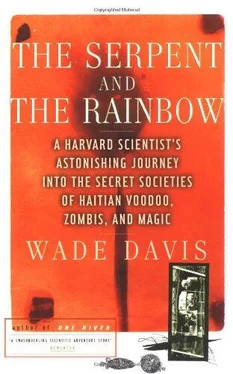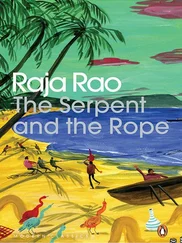Wade Davis - The Serpent and the Rainbow
Здесь есть возможность читать онлайн «Wade Davis - The Serpent and the Rainbow» весь текст электронной книги совершенно бесплатно (целиком полную версию без сокращений). В некоторых случаях можно слушать аудио, скачать через торрент в формате fb2 и присутствует краткое содержание. Год выпуска: 1985, Издательство: Simon & Schuster, Жанр: Старинная литература, на английском языке. Описание произведения, (предисловие) а так же отзывы посетителей доступны на портале библиотеки ЛибКат.
- Название:The Serpent and the Rainbow
- Автор:
- Издательство:Simon & Schuster
- Жанр:
- Год:1985
- ISBN:нет данных
- Рейтинг книги:5 / 5. Голосов: 1
-
Избранное:Добавить в избранное
- Отзывы:
-
Ваша оценка:
- 100
- 1
- 2
- 3
- 4
- 5
The Serpent and the Rainbow: краткое содержание, описание и аннотация
Предлагаем к чтению аннотацию, описание, краткое содержание или предисловие (зависит от того, что написал сам автор книги «The Serpent and the Rainbow»). Если вы не нашли необходимую информацию о книге — напишите в комментариях, мы постараемся отыскать её.
The Serpent and the Rainbow — читать онлайн бесплатно полную книгу (весь текст) целиком
Ниже представлен текст книги, разбитый по страницам. Система сохранения места последней прочитанной страницы, позволяет с удобством читать онлайн бесплатно книгу «The Serpent and the Rainbow», без необходимости каждый раз заново искать на чём Вы остановились. Поставьте закладку, и сможете в любой момент перейти на страницу, на которой закончили чтение.
Интервал:
Закладка:
If there were any doubts as to the ambitions of the new black military elite, they were to be quelled by events that took place following the invasion of Leclerc’s French army in 1801, the betrayal of Toussaint by Napoleon, and his ignoble deportation to France. The French, of course, had never intended to tolerate black rule in the colony, and even as Toussaint struggled to rebuild the plantations, plans for his overthrow were laid in Paris. Napoleon, himself, clearly identified his real military enemy in the colony and ordered his brother-in-law to concentrate his efforts, following the deportation of Toussaint, on destroying the remnants of the Maroon bands. As was predicted in Paris, it was a task that the French commander was able to assign to local generals that had so recently served under Toussaint—in particular Dessalines and Christophe, who by historical record applied themselves and their troops willingly to the slaughter.
Still the Maroons resisted, and as the pressure mounted their forces were in place to receive both black freedmen and mulattos into the final alliance that would wage the war of independence. There were a number of pitched battles, but there is little doubt that the tried-and-proven tactics of the Maroons—raids, fire, poison, ambush—provided the margin of victory. Yet in the final defeat of the French, the Maroons were as soon forgotten as they had been after the wars of Toussaint L’Ouverture. The dictatorial rulers that emerged in the vacuum of independence lost no time in revealing the depths of their dedication to equality or liberty. Christophe—a former slave who had fought by the side of Toussaint, taken part in the deceitful raid on the forces of Biassou and Jean François, and then temporarily joined hands with the French armies of Leclerc—became the ruler of the northern half of the country in 1806. He declared himself king, and in the ways of kings he wasted the lives of twenty thousand subjects to build himself an opulent palace and a fortress that would never fire a shot.
With Christophe the betrayal of the Maroons appeared to be complete, but their struggle, in fact, continued. Those of their leaders who were still alive, and who had been instrumental in maintaining the revolt, had long grown accustomed to deceit, and they were, if nothing else, resilient. In the early years of the republic, as they faced new oppressors, they also found a new and remarkable means of protecting their freedom.
Some fifty years ago, Zora Neale Hurston, a young American black woman and a former student of the great ethnographer Franz Boas, stumbled upon an extraordinary mystery while preparing for her first field trip to Haiti. In what was at the time perhaps the only reliable monograph on the vodoun society, she read that in the valley of Mirebalais there were secret societies that terrorized the local inhabitants. According to the author, the noted Africanist Melville Herskovits, these clandestine organizations were called together at night by the beating of one rock against another in a manner reminiscent of the Zangbeto, a secret society he had studied in Dahomey. So feared were these Haitian groups that only with great difficulty had Herskovits obtained the names of two. One was the bissago , whose members appeared at night “wearing horns and holding candles,” and the other was Les Cochons sans Poils—the Pigs without Hair. Both societies were believed capable of changing their members into animals and sending them into the night to spread evil.
Although this was the first report of secret societies in Haiti that Hurston had come across, the persistence of such a prominent West African cultural trait had not surprised her. For Zora Neale Hurston, born at the turn of the century in a small all-black village in Florida, had come at an early age to sense the African roots of her people. Her father was a Baptist preacher, and behind the frenzy of his service, the wailing gospel hymns, the sermons and spirit possession, she had perceived even as a young girl what she would recognize as the raw power of African worship. Nine years old when her mother died, Zora Neale promptly left home and drifted north, working as a maid for a traveling theatrical troupe before eventually ending up in Baltimore, where she finished her schooling. Luck rode with her, and her interest in literature and folklore led her to Howard University, and hence to a scholarship at Columbia. There she met Boas, who became her “Papa Franz,” her confidant, intellectual mentor, and strongest supporter.
At the time Franz Boas was in the process of revolutionizing the field of anthropology. In an era when British social anthropology was still an explicit tool of imperialism, he rejected arbitrary notions of progress and evolutionary theories that invariably placed Western society at the top of a social ladder. Instead he championed the need to study cultures because of their inherent value. Every culture possessed a certain logic, he would say, and they appeared peculiar to the outsider only because he or she did not understand that logic. More than anyone before him, Boas saw anthropology as a calling, an opportunity to herald the wonder of cultural diversity, while revealing the intricate weave of the human fabric that binds us all together. In the spirit of her teacher, Zora Neale Hurston had been one of the first to undertake scholarly research in the field of Afro-American folklore. At this time when racism was fashionable, she had written boldly that the “Hoodoo doctors [of the American South] practice a religion every bit as strict and formal as that of the Catholic Church.”
Inspired by Boas’s stress on the need for fieldwork, Zora Neale Hurston developed her own style, to say the least. Packing a pearl-handled pistol, she roamed the dusty backroads of the deep South in a beat-up Chevrolet, seeking out the hoodoo doctors, guitar players, and storytellers, herself playing just about as many roles as there were characters in the stories she collected. Sometimes they thought she was a bootlegger’s woman on the run, or a widow looking for a man. And when she sped away singing some bawdy song, they were certain she was a vaudeville star looking for new material. This amazing woman decked out in her beret and cheap cotton dresses, with all she possessed stuffed into a flimsy suitcase, reached into every bayou and woodlot in the South, and when she got there she carried to its limits what anthropologists stiffly call participant observation. Once to satisfy a hoodoo priest she had to steal a black cat, then kill it by dropping it into boiling water; after the flesh fell away, she was instructed to pass each bone through her teeth until one tasted bitter. During an initiation ceremony in New Orleans, she had to lie naked for sixty-nine hours on a couch with a snakeskin touching her navel; at the tolling of the seventieth hour, five men lifted her from the floor and began a long ritual that culminated with the painting of a symbolic streak of lightning across her back. Then the hoodoo priest passed around a vessel of wine mixed with the blood of all present. Only by sharing in this ritual drink did Zora Neale become accepted by the cult.
It was this spirit of adventure combined with a passionate desire to continue her investigations and promote vodoun as a legitimate and complex religion that drew Hurston to Haiti. There is little doubt that by the time she read of the secret societies her proposed journey had become something of a personal crusade. For some time American and European foreign correspondents had indulged their readers’ perverse infatuation with what was known as the Black Republic, serving it up garnished with every conceivable figment of their imaginations. For Americans, in particular, Haiti was like having a little bit of Africa next door, something dark and foreboding, sensual and terribly naughty. Popular books of the day, with such charming titles as Cannibal Cousins and Black Bagdad , cast the entire nation as a caricature, an impoverished land of throbbing drums ruled by pretentious buffoons and populated by swamp doctors, licentious women, and children bred for the cauldron. Most of these travelogues would have been soon forgotten had it not been for the peculiar and by no means accidental timing of their publication. Until the first of this genre appeared in 1880—Spenser St. John’s The Black Republic , with its infamous account of a cannibalistic “Congo Bean Stew”—most books that dealt with vodoun had simply emphasized its role in the slave uprising. But these new and sensational books, packed with references to cult objects such as voodoo dolls that didn’t even exist, served a specific political purpose. It was no coincidence that many of them appeared during the years of the American occupation (1915-1934), and that every Marine above the rank of captain seemed to manage to land a publishing contract. There were many of these books, and each one conveyed an important message to the American public—any country where such abominations took place could find its salvation only through military occupation. Zora Neale Hurston, as much as anyone, was aware of these slanderous accounts, and she was quick to realize how the material she had collected in the American South could be exploited if placed in the wrong hands. Thus it was not only a trained but a judicious eye that now was turned on the Haitian secret societies.
Читать дальшеИнтервал:
Закладка:
Похожие книги на «The Serpent and the Rainbow»
Представляем Вашему вниманию похожие книги на «The Serpent and the Rainbow» списком для выбора. Мы отобрали схожую по названию и смыслу литературу в надежде предоставить читателям больше вариантов отыскать новые, интересные, ещё непрочитанные произведения.
Обсуждение, отзывы о книге «The Serpent and the Rainbow» и просто собственные мнения читателей. Оставьте ваши комментарии, напишите, что Вы думаете о произведении, его смысле или главных героях. Укажите что конкретно понравилось, а что нет, и почему Вы так считаете.












